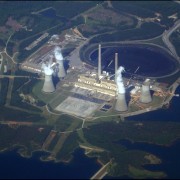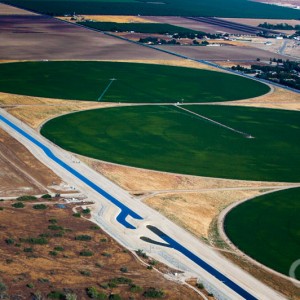EPA Clean Power Plan Delivers Significant Benefits for Water
Cutting carbon emissions from power plants will lead to reductions in water use, water withdrawals, and mercury pollution in rivers and lakes.

By Brett Walton
Circle of Blue
An Obama administration plan to cut heat-trapping and ocean-acidifying carbon emissions from U.S. power plants comes with a large dividend for the nation’s water resources, according to researchers who study the connections between energy production and water supplies.
The primary goal of the Clean Power Plan, finalized by the U.S. Environmental Protection Agency on August 3, is to push electricity generation away from coal and toward natural gas, wind, and solar power. Supporters of the plan — which targets a 32 percent reduction in carbon emissions by 2030, compared with 2005 levels — hope it is a signal that America is serious about clinching an international climate deal at a United Nations summit in Paris this December.
–Steve Clemmer, director of energy research
Union of Concerned Scientists
Designed to address a global problem, the plan also promises substantial local benefits for watersheds and human health. This new era of electric power in America will require much less water than the current system, which is dominated by facilities that burn coal in steam-driven turbines, an old technology that, along with nuclear power, is among the most water-intensive methods of producing electricity.
“Yes, there will be water savings,” Steve Clemmer, director of energy research at the Union of Concerned Scientists, told Circle of Blue. “We can say that with a high level of confidence.”
Droughts in the Southeast and Southwest in the last decade revealed the power sector’s vulnerability to diminishing flows of fresh water. Power plants in Alabama, in 2007, and Tennessee, in 2011, were forced to shut down because river flows were too low or too warm. Drought in California cut the state’s hydropower generation nearly in half in 2014, compared to the 10-year average.
“There are lots of examples of these problems already happening, and they are going to get worse because of climate change,” Clemmer said. “The Clean Power Plan helps address that future issue of drought and heat waves causing more problems for the energy sector.”
Water savings is only half the story. Water pollution should decrease as well. Fewer coal plants means less mercury in rivers and lakes. Mercury, which damages the brain and is especially debilitating for infants and children, is emitted into the air when coal is burned. It then settles into waterbodies, where it accumulates in fish and other aquatic species and is converted into methylmercury, a compound that is more toxic to humans.
Researchers who spoke with Circle of Blue about the plan’s consequences for water resources discussed the potential outcomes in broad terms because quantitative assessments have not yet been done and the effects will vary by region and watershed. The Union of Concerned Scientists will do an analysis, Clemmer said, but the research group is still attempting to understand the plan’s nuances.
Some of the uncertainty is due to the plan’s flexibility. Jordan Macknick, an energy analyst at the National Renewable Energy Laboratory who studies water and energy, said that because the Clean Power Plan allows states to develop their own low-carbon paths, many of the details are still to be written. State plans are due by September 2016.
“I’ll be interested to see how many states incorporate water benefits into their plans,” Macknick told Circle of Blue, citing Colorado as one of the few states that acknowledged water savings in its existing renewable energy standard, which was approved in 2004 and strengthened in 2010.
In the meantime, researchers point to a number of existing studies that can serve as surrogates for predicting the Clean Power Plan’s benefits to water.
Water Quantity — Changing Power Plant Designs and Fuels Will Equal Water Savings
Water use in the power sector is measured in two ways: withdrawals, which is the amount taken out of waterways, and consumption, which measures what is used up and not discharged back into the river.
Thermal power plants accounted for 38 percent of U.S. freshwater withdrawals in 2010, according to the U.S. Geological Survey. Both withdrawals and consumption will change as the Clean Power Plan is implemented.
The changes depend on two factors, according to Clemmer: generation technology and cooling technology.
Wind turbines and solar photovoltaic panels are two generation technologies that withdraw and use almost no water. The Clean Power Plan notes that generating 20 percent of the nation’s electricity from wind, solar, and geothermal by 2030 is technically feasible. What might this look like for water?
The Department of Energy has a partial answer. In the Wind Vision study, published in March 2015, the department found that boosting wind power to 20 percent of U.S. electricity generation by 2030 would cut water withdrawals by 4 percent and consumption by 11 percent. The wind target of 20 percent is similar to what the U.S. Energy Information Administration says is likely for renewable energy development under the Clean Power Plan, Clemmer said.
Some regions stand to benefit more than others. The wind study found that in 11 of the country’s 18 largest watersheds, water consumption was reduced by more than 30 percent. The biggest declines are in the Great Plains, Northeast, Pacific Northwest, and Upper Midwest.
Water savings also come from a shift to natural gas. Combined cycle turbines, which run on natural gas, are much more water-efficient than the steam turbines that drive many coal plants. Combined cycle turbines waste less heat and thus require less water for cooling.
Researchers at the University of Texas measured water consumption for the two technologies in Texas. They found that facilities with natural gas combined cycle turbines used three times less water per kilowatt-hour than coal plants with steam turbines.
“We’ve already seen such a reduction in water use in Texas because of the large number of combined cycle plants that were built since 2000,” Bridget Scanlon, a research scientist and the study’s lead author, told Circle of Blue. Scanlon said that the data on water consumption from Texas can be used for national comparisons.
The Clean Power Plan does not directly address cooling technology, which is covered in a separate EPA rule that was released in 2014. Most of the coal plants that will be retired because of the Clean Power Plan, however, use a technology called once-through cooling that requires massive water withdrawals. Ending the use of plants with once-through cooling will reduce withdrawals and prevent millions of fish larvae from being destroyed by the intake pumps.
Water Quality
Coal plants are the largest source of mercury emissions in the United States, contributing roughly 55 percent of the total, according to the U.S. Geological Survey. Some of the mercury in the air eventually settles in rivers and lakes, where it is consumed by fish and leads to fishing restrictions for people.
Mercury’s ability to impair infant brains is well understood, but less certain is how much of the power plant emissions turn up in water bodies.
“Sourcing the mercury that is getting into rivers, I would say, is one of the most poorly understood aspects of environmental mercury research,” Dave Krabbenhoft, a research hydrologist at the U.S. Geological Survey, told Circle of Blue.
Krabbenhoft’s colleague Mark Brigham said that there will be a reduction in mercury deposition into rivers, but pinning down an exact number is difficult. The amount that falls out of the sky varies depending on the quality of the coal, the form of mercury that is emitted, wind patterns, and atmospheric chemistry, Brigham explained.
Nonetheless, the regions with the highest concentration of coal plants and the communities downwind, particularly in the eastern half of the United States, will reap the greatest benefit.
“If you live in upstate New York and Pennsylvania and you’re downwind of the Ohio Valley and other places where there have historically been tightly clustered coal burning units in that part of the world, we would expect to see improvement in those areas,” Krabbenhoft said.
The U.S. Supreme Court struck down an EPA rule in June that addresses mercury pollution from power plants, but the Clean Power Plan will also help reduce emissions. The EPA will resubmit a revised mercury rule by spring of 2016.
Brett writes about agriculture, energy, infrastructure, and the politics and economics of water in the United States. He also writes the Federal Water Tap, Circle of Blue’s weekly digest of U.S. government water news. He is the winner of two Society of Environmental Journalists reporting awards, one of the top honors in American environmental journalism: first place for explanatory reporting for a series on septic system pollution in the United States(2016) and third place for beat reporting in a small market (2014). He received the Sierra Club’s Distinguished Service Award in 2018. Brett lives in Seattle, where he hikes the mountains and bakes pies. Contact Brett Walton












Leave a Reply
Want to join the discussion?Feel free to contribute!